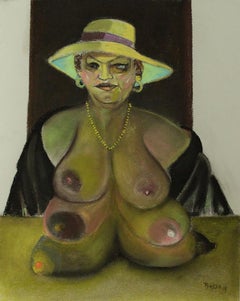Joe Basso
2010s Neo-Expressionist Nude Drawings and Watercolors
Paper, Charcoal, Pastel, Archival Paper
Stephen Basso for sale on 1stDibs
A Close Look at Neo-expressionist Art
A resurgence of interest in Expressionism, Pop art, Surrealism, Abstract Expressionism and other movements gained steam among artists of the 1970s and ’80s, in part as a reaction to the austerity of the prevailing minimalism and Conceptual art of the era. A decadent, bold and brash art style called Neo-Expressionism saw painters returning to figural representation, creating highly textured works that were imbued with intensely personal narratives.
Neo-Expressionist paintings are sensuous in nature and highly subjective in meaning. Expressive brushwork, highly pigmented colors and layered forms and materials lent sculptural attributes to the work and were used to depict symbolic narratives from history, mythology and the artist’s personal experience.
Prominent figures such as Jean-Michel Basquiat led the Neo-Expressionist movement in the United States with paintings and prints that were raw, emotional and often violent in nature. In Germany, Die Neuen Wilden (the “New Fauves”) was the name given to a group of postwar artists that included the likes of sculptor Georg Baselitz and Gerhard Richter, a painter and photographer who explored the possibilities of both abstraction and realism, sometimes in a single piece. The work of the New Fauves — labeled as such for its return to Fauvism’s textured brushwork and use of vibrant colors — shares commonalities with Neo-Expressionism, and Baselitz was a pioneer of the movement in Europe. In addition, Willem de Kooning’s pulsating action paintings and Julian Schnabel’s experimentation with the materiality of paintings also took shape during this period.
“I was trying to make paintings different from the paintings that I saw a lot of at the time, which were mostly minimal, and they were highbrow and alienating, and I wanted to make very direct paintings that most people would feel the emotion behind when they saw them,” said Basquiat.
Neo-Expressionism generated some polarizing opinions, with some celebrating the revival of personal subjectivity in art while others criticizing the movement for being too commercially driven and nostalgic. But most experts agree that Neo-Expressionism was a huge commercial success and culturally impactful, paving the way for the postmodern work of artists like Richter and Sigmar Polke.
Find original Neo-Expressionist paintings, prints, mixed-media works and other art on 1stDibs.
Finding the Right Nude-drawings-watercolors for You
The human body has long been a favorite subject for artists throughout history. Nude drawings and watercolor paintings reveal the human figure but also the social ideals, traditions and cultural beliefs around people and bodies at the time they were created.
Nude drawings and watercolors offer a unique way to illustrate the human body. Drawings in pencil or ink can quickly capture movement or poses while watercolor is more expressive of a moment. Different cultures utilize the same materials differently, and each piece provides a singular glimpse into the perspectives and expectations around people’s bodies.
Artists like Francisco Goya, Gustav Klimt and Lucian Freud — who painted his friends, his lovers and his children — found acclaim and success by creatively depicting the human body. More recently, as contemporary artists have followed the figurative muse, many painters are exploring the nude as a subject for their drawings and works in watercolors.
If you’re thinking about bringing this kind of work into your space, there are many ways to consider how to arrange wall art in your living room or elsewhere in your home. Creating a wall of art is a wonderful way to enhance your space, showcase beautiful pieces and tie an interior design vision together. It allows you to evoke emotions in a room while also showing off your tastes and interests.
On 1stDibs, find a collection of nude drawings and watercolor paintings for diverse views and attitudes toward the human form through a range of cultures and times.
